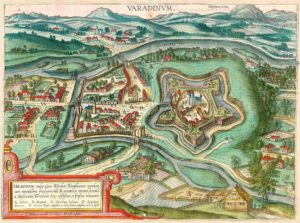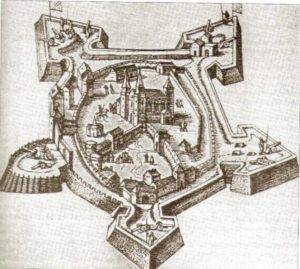27 August 1660: The fall of Várad castle

We have to commemorate the heroic siege of Nagyvárad / Várad (Oradea) in 1660. The defenders’ deeds can be compared to the warriors of Eger (1552), even though they weren’t victorious. After the loss of Nagyvárad, the Habsburgs received criticism internationally because the whole Partium (a great area between Transylvania and Royal Hungary) had gone under Turkish control. Its loss marked the end of Transylvania’s independence. Here is more about the history of Várad / Nagyvárad:
https://www.hungarianottomanwars.com/transylvania/nagyvarad/

The siege of Nagyvárad was the direct outcome of the unlucky politics of late Prince Rákóczi II György of Transylvania. After his disastrous Polish campaign, he was fighting an unbalanced war to keep his throne. The Sultan launched several punishing campaigns against him and Transylvania was covered in flames but the Hajdú towns also suffered a lot. Here is an article about the heroic death of a Hajdú warrior called Kádár István who lost his life in 1658 while defending his people with his tiny unit:
https://www.hungarianottomanwars.com/essays/kadar-istvan-and-his-hajdu-soldiers-1658/

Kádár’s heroism can be compared to the Hungarian Székelys’ deed in the Battle of Szárhegy in Transylvania that took place during the same year. Note, without the bravery of these low-ranked soldiers and commoners, the whole nation would have perished a long time ago. Here is more about the Battle of Szárhegy:
https://www.hungarianottomanwars.com/1541-1699/the-battle-of-szarhegy-1658/

Finally, Grand Vizier Köprülü Mehmed has got utterly angry at Rákóczi’s desperate attempts and sent the Ottoman troops towards the Transylvanian Principality again in 1660. Pasha Szejdi Ahmed of Buda with his Turks and Crimean Tatar army destroyed the towns of the Hungarian Hajdú district including Debrecen: it was the terrible “Szejdi-raid” or as it was called among the Hungarians, the “Szejdi-járás”.

Then, Ahmed joined forces with Serdar-Pasha Ali of Temesvár in May 1660 and defeated Prince Rákóczi at Szászfenes. Two weeks later, the Prince died of his wounds on 7 June in Nagyvárad. Here is more about the Battle of Szászfenes:

His body was taken to Gyulafehérvár (Alba Iulia), the capital of Transylvania. Unfortunately, Gyulay Ferenc, the captain of Nagyvárad castle went to the burial, along with most of the guards. Várad remained unguarded and Ali and Ahmed didn’t let the chance go. Nagyvárad was a serious fort, whoever owned it, could control Transylvania’s gate. Várad castle was defending the counties of the Trans-Tisza River, including the Hajdú towns and Debrecen. It had to be taken by the Turks.

Only 850 untrained soldiers were left behind under the leadership of Balogh Máté, his vice-captain. Most of the defenders were students of the famous College of Várad. The officers were Rácz János, Ibrányi Mihály, and Szalárdi János. The latter was the one who wrote down the history of the siege. (Please, note that I use the Oriental name order for Hungarians where family names come first.) At that time, Várad was a well-fortified castle on the bank of the Sebes Kőrös River, five strong Italian-style bastions were around it.

According to the inventory of 1633, there were 69 cannons in it but the defenders lacked military knowledge so much that they couldn’t even use their own cannons. They had no idea how to defend against the Turkish mines, either. However, they were valiant in close combat.

On the other hand, Pasha Achmed and Pasha Ali of Temesvár with 50,000 seasoned soldiers set out to capture the important castle that guarded immense territories. They surrounded the castle on 14 July and the systematic siege began. The extremely hot summer also helped the besiegers but still, it took them a month to drain the water of the moat and destroy the walls with mines and artillery. Then, the Ottoman warriors assaulted the breaches but they were repulsed each time. Finally, after 44 days of all resistance, the further fight proved futile so vice-captain Balogh left the castle with his people under the terms that the city wouldn’t be sacked.

They ceded the castle on 27 August to the Turks. Pasha Ali appreciated their bravery and granted them unusually good terms. All the defenders were allowed to leave, along with their family members. The students of the College were allowed to take away the entire equipment of the school.

At the same time, near the border of Royal Hungary, there was the sizable army of General Souches who refused the begging and pleading of the city and denied even minimal help against the Turks. Souches had wanted to but the Military Council of Vienna strictly banned him from giving any help.


Zrínyi Miklós aka Nikola Zrinski and the fall of Várad castle
The famous statesman, general, and poet also grieved upon the loss of Várad and blamed it on the Habsburgs. At this time, his loyalty to the Habsburg king was already a bit forsaken. He wrote his work “The Remedy for the Turkish Opium” in 1661, and he bitterly remarked upon the fall of Várad castle. Let me quote his words:

“Let us just see and consider our present state. Now, if the Turks do anything, we run up and down, across the water and over the mountains, one here another there, and our only remedy is begging others for help. We do not have people to stand up against the danger, or anybody to deploy. Almighty God, this is a terrible shame! Are we Hungarians? We Hungarians? We must not call ourselves Hungarians if we do not recapture Várad, if we lose Transylvania, we must even stop warfighting as it is now or never. If we cannot do this, let us run away from the country. I hear there is enough vacant land in Brazil. Let us ask the King of Spain for a province there, let us establish a colony there, and let us turn into commoners.”
(Let us note that Brazil was a colony of Portugal from 1500 to 1815 and not of Spain.)


Dear Readers, I can only make this content available through small donations or by selling my books or T-shirts.
If you like my writings, please feel free to support me with a coffee here:
You can check out my books on Amazon or Draft2Digital, they are available in hardcover, paperback, or ebook:
https://www.amazon.com/dp/198020490X
or at https://books2read.com/b/boYd81


My work can also be followed and supported on Patreon: Become a Patron!http://Become a Patron!


https://hungarianottomanwars.myspreadshop.com/

https://hungarianottomanwars.myspreadshop.com/all


